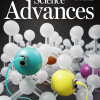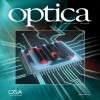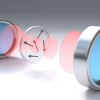
Spectral Multiplexing of Rare-Earth Emitters in a Co-Doped Crystalline Membrane
A. Ulanowski, J. Früh, F. Salamon, A. Holzäpfel, A. Reiserer
Advanced Optical Materials 12 (15), 10 (2024).
The spectral addressing of many individual rare-earth dopants in optical resonators offers great potential for realizing distributed quantum information processors. To this end, it is required to understand and control the spectral properties of the emitters in micron-scale devices. Here, erbium emitters are investigated in a Fabry-Perot resonator that contains a 10 mu m thin membrane of crystalline yttrium orthosilicate that is co-doped with europium. The co-doping allows for tailoring the inhomogeneous distribution of the emitter frequency. With this approach, more than 360 spectrally resolved emitters are observed with Purcell factors exceeding 35, each of which constitutes an individually addressable qubit within the micron-scale resonator. In addition to this spectral multiplexing, the optical coherence is preserved up to 0.62(3) ms under dynamical decoupling. Without decoupling, the coherence still reaches the lifetime limit for the emitters with the strongest Purcell enhancement that leads up to a 110-fold lifetime reduction, down to 0.104(9) ms. Future work may combine this with long-lived nuclear spin memories, which makes the investigated co-doped membranes a promising platform for quantum repeaters and distributed quantum computers.

Light-matter interactions in quantum nanophotonic devices
A. González-Tudela, A. Reiserer, J. J. García-Ripoll, F. J. García-Vidal
Nature Reviews Physics 6 (3), 166-179 (2024).
Nanophotonics offers opportunities for engineering and exploiting the quantum properties of light by integrating quantum emitters into nanostructures, and offering reliable paths to quantum technology applications such as sources of quantum light or new quantum simulators, among many others. In this Review, we discuss common nanophotonic platforms for studying light-matter interactions, explaining their strengths and experimental state-of-the-art. Each platform works at a different interaction regime: from standard cavity quantum electrodynamics (QED) setups to unique quantum nanophotonic devices, such as chiral and non-chiral waveguide QED experiments. When several quantum emitters are integrated into nanophotonic systems, collective interactions emerge, enabling miniaturized, versatile and fast-operating quantum devices. We conclude with a perspective on the near-term opportunities offered by nanophotonics in the context of quantum technologies. Quantum nanophotonics examines the interaction between emitters and light confined at the nanoscale. This Review highlights the experimental progress in the field, explains new light-matter interaction regimes and emphasizes their potential applications in quantum technologies. Nanophotonics is the field that studies how to control the properties of light at the nanoscale.It began in the late 1980s with the discovery of photonic crystals, followed by subsequent waves that harnessed metals and metamaterials to engineer unique photon flows at the (semi)classical level.Current experimental efforts aim at integrating these setups with natural and artificial atoms to control the light properties at the quantum level.Apart from reducing the mode volume of light and thus enhancing light-matter interactions, nanophotonic setups allow the exploration of new regimes that exploit non-trivial energy dispersions and polarization patterns.Quantum nanophotonics creates unique opportunities to develop a new generation of miniaturized, versatile and fast-operating quantum technologies.

Colloquium: Cavity-enhanced quantum network nodes
A. Reiserer
Reviews of Modern Physics 94 (4), 41003 (2023).
A future quantum network will consist of quantum processors that are connected by quantum channels, just like conventional computers are wired up to form the Internet. In contrast to classical devices, however, the entanglement and nonlocal correlations available in a quantum-controlled system facilitate novel fundamental tests of quantum theory. In addition, they enable numerous applications in distributed quantum information processing, quantum communication, and precision measurement. While pioneering experiments have demonstrated the entanglement of two quantum nodes separated by up to 1.3 km, and three nodes in the same laboratory, accessing the full potential of quantum networks requires scaling of these prototypes to many more nodes and global distances. This is an outstanding challenge, posing high demands on qubit control fidelity, qubit coherence time, and coupling efficiency between stationary and flying qubits. This Colloquium describes how optical resonators facilitate quantum network nodes that achieve the aforementioned prerequisites in different physical systems (trapped atoms, defect centers in wide-band-gap semiconductors, and rare-earth dopants) by enabling high-fidelity qubit initialization and readout, efficient generation of qubit-photon and remote qubit-qubit entanglement, and quantum gates between stationary and flying qubits. These advances open a realistic perspective toward the implementation of global-scale quantum networks in the near future.

Erbium emitters in commercially fabricated nanophotonic silicon waveguides
S. Rinner, F. Burger, A. Gritsch, J. Schmitt, A. Reiserer
Nanophotonics 12 (17), 3455-3462 (2023).
Quantum memories integrated into nanophotonic silicon devices are a promising platform for large quantum networks and scalable photonic quantum computers. In this context, erbium dopants are particularly attractive, as they combine optical transitions in the telecommunications frequency band with the potential for second-long coherence time. Here, we show that these emitters can be reliably integrated into commercially fabricated low-loss waveguides. We investigate several integration procedures and obtain ensembles of many emitters with an inhomogeneous broadening of <2 GHz and a homogeneous linewidth of <30 kHz. We further observe the splitting of the electronic spin states in a magnetic field up to 9 T that freezes paramagnetic impurities. Our findings are an important step toward long-lived quantum memories that can be fabricated on a wafer-scale using CMOS technology.

Purcell enhancement of single-photon emitters in silicon
A. Gritsch, A. Ulanowski, A. Reiserer
Optica 10 (6), 783-789 (2023).
Individual spins that are coupled to telecommunication photons offer unique promise for distributed quantum information processing once a coherent and efficient spin-photon interface can be fabricated at scale. We implement such an interface by integrating erbium dopants into a nanophotonic silicon resonator. We achieve spin-resolved excitation of individual emitters with <0.1 GHz spectral diffusion linewidth. Upon resonant driving, we observe optical Rabi oscillations and single-photon emission with a 78-fold Purcell enhancement. Our results establish a promising platform for quantum networks. (c) 2023 Optica Publishing Group under the terms of the Optica Open Access Publishing Agreement

Narrow Optical Transitions in Erbium-Implanted Silicon Waveguides
A. Gritsch, L. Weiss, J. Fruh, S. Rinner, A. Reiserer
Physical Review X 12 (4), 41009 (2022).
The realization of a scalable architecture for quantum information processing is a major challenge for quantum science. A promising approach is based on emitters in nanostructures that are coupled by light. Here, we show that erbium dopants can be reproducibly integrated at well-defined lattice sites by implantation into pure silicon. We thus achieve a narrow inhomogeneous broadening, less than 1 GHz, strong optical transitions, and an outstanding optical coherence even at temperatures of 8 K, with an upper bound to the homogeneous linewidth of around 10 kHz. Our study thus introduces a promising materials platform for the implementation of on-chip quantum memories, microwave-to-optical conversion, and distributed quantum information processing.

Spectral multiplexing of telecom emitters with stable transition frequency
A. Ulanowski, B. Merkel, A. Reiserer
Science Advances 8 (43), eabo4538 (2022).
In a quantum network, coherent emitters can be entangled over large distances using photonic channels. In solid-state devices, the required efficient light-emitter interface can be implemented by confining the light in nano-photonic structures. However, fluctuating charges and magnetic moments at the nearby interface then lead to spectral instability of the emitters. Here, we avoid this limitation when enhancing the photon emission up to 70(12)-fold using a Fabry-Perot resonator with an embedded 19-micrometer-thin crystalline membrane, in which we observe around 100 individual erbium emitters. In long-term measurements, they exhibit an exceptional spec-tral stability of <0.2 megahertz that is limited by the coupling to surrounding nuclear spins. We further implement spectrally multiplexed coherent control and find an optical coherence time of 0.11(1) milliseconds, approaching the lifetime limit of 0.3 milliseconds for the strongest-coupled emitters. Our results constitute an important step toward frequency-multiplexed quantum-network nodes operating directly at a telecommunication wavelength.

(28)Silicon-on-insulator for optically interfaced quantum emitters
Y. J. Liu, S. Rinner, T. Remmele, O. Ernst, A. Reiserer, T. Boeck
Journal of Crystal Growth 593, 126733 (2022).
The coherence of optical emitters in silicon waveguides is impaired by the coupling to the surrounding bath of 29Si nuclear spins. We eliminate this obstacle by fabricating isotopically enriched silicon-on-insulator (SOI) chips. To this end, we use molecular beam epitaxy to grow a 0.4 mu m thin 28Si layer with a 29Si concentration < 0.006% on a 70 nm thin SOI seed chip. the resulting layer reveals a high crystalline quality and has a low defect concentration, determined from secondary ion mass spectroscopy, dark field plane-view and cross-view transmission electron microscope images as well as X-ray diffraction. With its low surface roughness, measured by atomic force microscopy, the grown layer is a promising material for the integration of optically interfaced quantum emitters in low-loss nanophotonic waveguides that are free from nuclear spins.

Cavity-enhanced quantum network nodes
A. Reiserer
arXiv:2205.15380 (2022).
A future quantum network will consist of quantum processors that are connected by quantum channels, just like conventional computers are wired up to form the Internet. In contrast to classical devices, however, the entanglement and non-local correlations available in a quantum-controlled system facilitate novel fundamental tests of quantum theory. In addition, they enable numerous applications in distributed quantum information processing, quantum communication, and precision measurement.
While pioneering experiments have demonstrated the entanglement of two quantum nodes separated by up to 1.3 km, and three nodes in the same laboratory, accessing the full potential of quantum networks requires scaling of these prototypes to many more nodes and global distances. This is an outstanding challenge, posing high demands on qubit control fidelity, qubit coherence time, and coupling efficiency between stationary and flying qubits.
In this work, I will describe how optical resonators facilitate quantum network nodes that achieve the above-mentioned prerequisites in different physical systems -- trapped atoms, defect centers in wide-bandgap semiconductors, and rare-earth dopants -- by enabling high-fidelity qubit initialization and readout, efficient generation of qubit-photon and remote qubit-qubit entanglement, as well as quantum gates between stationary and flying qubits. These advances open a realistic perspective towards the implementation of global-scale quantum networks in the near future.

Dynamical Decoupling of Spin Ensembles with Strong Anisotropic Interactions
B. Merkel, P. C. Farina, A. Reiserer
Physical Review Letters 127 (3), 30501 (2021).
Ensembles of dopants have widespread applications in quantum technology. The miniaturization of corresponding devices is however hampered by dipolar interactions that reduce the coherence at increased dopant density. We theoretically and experimentally investigate this limitation. We find that dynamical decoupling can alleviate, but not fully eliminate, the decoherence in crystals with strong anisotropic spin-spin interactions that originate from an anisotropic g tensor. Our findings can be generalized to many quantum systems used for quantum sensing, microwave-to-optical conversion, and quantum memory.

Coherent Control in the Ground and Optically Excited States of an Ensemble of
P. C. Farina, B. Merkel, N. H. Valencia, P. H. Yu, A. Ulanowski, A. Reiserer
Physical Review Applied 15 (6), 64028 (2021).
Ensembles of erbium dopants can realize quantum memories and frequency converters that operate in the minimal-loss wavelength band of fiber optical communication. Their operation requires the initialization, coherent control, and readout of the electronic spin state. In this work, we use a split-ring microwave resonator to demonstrate such control in both the ground and optically excited state. The presented techniques can also be applied to other combinations of dopant and host and may facilitate the further development of quantum memory protocols and sensing schemes.

Laser stabilization to a cryogenic fiber ring resonator
B. Merkel, D. Repp, A. Reiserer
Optics Letters 46 (2), 444-447 (2021).
The frequency stability of lasers is limited by thermal noise in state-of-the-art frequency references. Further improvement requires operation at cryogenic temperature. In this context, we investigate a fiber-based ring resonator. Our system exhibits a first-order temperature-insensitive point around 3.55 K, much lower than that of crystalline silicon. The observed low sensitivity with respect to vibrations (<5 . 10(-11) m(-1) s(2)), temperature (-22(1) . 10(-9) K-2), and pressure changes (4.2(2) . 10(-11) mbar(-2)) makes our approach promising for future precision experiments. (C) 2021 Optical Society of America

Erbium dopants in nanophotonic silicon waveguides
L. Weiss, A. Gritsch, B. Merkel, A. Reiserer
Optica 8 (1), 40-41 (2021).
We perform resonant spectroscopy of erbium implanted into nanophotonic silicon waveguides, finding 1 GHz inhomogeneous broadening and homogeneous linewidths below 0.1 GHz. Our study thus introduces a promising materials platform for on-chip quantum information processing. (C) 2021 Optical Society of America under the terms of the OSA Open Access Publishing Agreement

Coherent and Purcell-Enhanced Emission from Erbium Dopants in a Cryogenic High-Q Resonator
B. Merkel, A. Ulanowski, A. Reiserer
Physical Review X 10 (4), 41025 (2020).
The stability and outstanding coherence of dopants and other atomlike defects in tailored host crystals make them a leading platform for the implementation of distributed quantum information processing and sensing in quantum networks. Albeit the required efficient light-matter coupling can be achieved via the integration into nanoscale resonators, in this approach the proximity of interfaces is detrimental to the coherence of even the least-sensitive emitters. Here, we establish an alternative: By integrating a 19 mu m thin crystal into a cryogenic Fabry-Perot resonator with a quality factor of 9 x 10(6), we achieve a two-level Purcell factor of 530(50). In our specific system, erbium-doped yttrium orthosilicate, this leads to a 59(6)-fold enhancement of the emission rate with an out-coupling efficiency of 46(8)%. At the same time, we demonstrate that the emitter properties are not degraded in our approach. We thus observe ensemble-averaged optical coherence up to 0.54(1) ms, which exceeds the 0.19(2) ms lifetime of dopants at the cavity field maximum. While our approach is also applicable to other solid-state quantum emitters, such as color centers in diamond, our system emits at the minimal-loss wavelength of optical fibers and thus enables coherent and efficient nodes for long-distance quantum networks.
